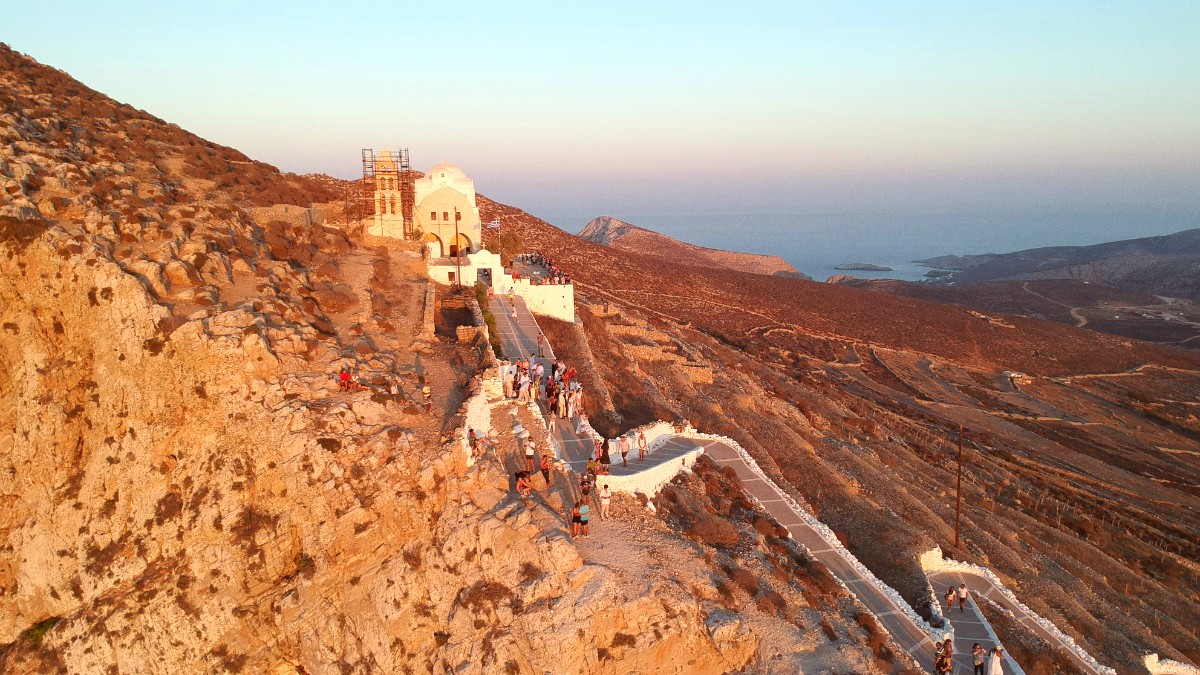
Greece
This 11th-century Byzantine monastery is a must-visit site. Builders crafted it directly into the side of a sheer cliff, 300 meters (about 980 feet) above the Aegean Sea. It has breathtaking views.
The monastery is located southeast of Chora. It typically opens daily from 8 AM to 1 PM and again from 5 PM to 7 PM, though hours can vary. Entry is free, but donations are welcome. Modest dress is required: shoulders and knees must be covered. The monastery often provides wraps for visitors. Arrive early to avoid crowds and heat. Photography inside is often restricted; observe signs.
Combine a visit here with time in Katapola.
Remains of an ancient city-state near Vroutsi, includes ancient wall and tower.
Archaeological remains of the ancient city of Aegiali, located on a hill above Aegiali port.
Its entire old town is a historical district, showing Cycladic architecture, windmills, and Byzantine churches.
Numerous small churches and chapels scatter across the island, many Byzantine era.
Small, iconic chapel near Monastery of Hozoviotissa, featured in "The Big Blue" film.
Amorgos's natural landscape invites exploration and relaxation.
Amorgos has no formal parks; the island's entire landscape is a natural wonder.
A sea cave accessible by swimming from Mouros beach.
A small chapel with panoramic views over the Aegean and sunset.
Home to various bird species and local fauna like wild goats. Bird watching is popular.
Dramatic cliffs near Ancient Arkesini, providing stunning sea views.
The island has no significant lakes or rivers. It relies on springs and desalination plants.
A small, picturesque pebble beach below the Monastery of Hozoviotissa. It is known for its deep blue waters.
A popular pebble beach with unique underwater caves for snorkeling.
A sheltered sandy beach in the south, suitable for families.
Many beaches are on the island, suitable for different preferences.
Beyond the main attractions, Amorgos holds smaller, less-visited treasures.
Explore the coastline by rental boat or walking to find quiet, private spots. Many remote chapels and hiking paths not explicitly listed on tourist maps mean solitude and stunning views. The traditional villages of Tholaria and Langada, while gaining popularity, still provide a more authentic experience than the main towns.
Discover unique spots away from the usual tourist paths.
Capture memorable shots at these picturesque locations.
Consider enriching your visit with organized tours.
Plan your route to make the most of your time.
Tailor your sightseeing to your interests and the time you have on Amorgos.
Focus on iconic landscapes: Monastery of Hozoviotissa, Chora's alleys, and the Shipwreck Olympia.
Explore Ancient Minoa, Arkesini, and the Archaeological Museum in Gavras Tower.
Visit Agia Anna, Mouros, and the sandy beaches of Aegiali like Psili Ammos.
For various tours and activities, check out GetYourGuide.
Book your Amorgos adventures hereInquire at local travel agencies in Katapola or Aegiali for island tours.
Websites and blogs focusing on Amorgos travel can offer more insights.
Local tourist information centers often have brochures and staff assistance.
After sunset, Chora transforms into a magical place.
Consider exploring nearby islets for a different perspective.
Bring sturdy walking shoes. Exploring Chora's alleys and hiking to viewpoints means lots of steps and uneven surfaces.
Sun protection, water, and comfortable clothing are also good for daytime sightseeing.
Responsible tourism helps keep Amorgos pristine.
Amorgos thrives on its unspoiled natural environment.
Your choices have an impact on the local economy.
Amorgos has a deep cultural heritage.
These actions contribute to a positive experience for everyone.
Be kind to the island's animals.
Many animals on the island are accustomed to human presence.
Proper waste disposal is on a small island.
Small actions make a big difference.
Participate in festivals (panigiria) or village gatherings.
Purchase handcrafted goods directly from local artisans.
A few Greek words go a long way in showing respect.